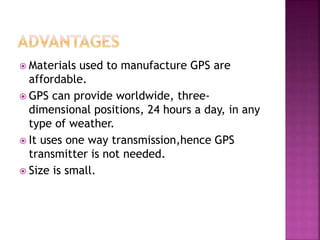Global positioning system
- 2. Introduction The GPS satellite system Working of GPS Components of a GPS Applications Advantages and disadvantages Conclusion
- 3. GPS was created and realised by US department of defence(USDOD). GPS is a space-based global navigation satellite(GNSS). Used for reliable location and time information. It works in all weather conditions and all times and day where on or near the earth.
- 4. There is no subscription fee and setup charges to use GPS. GPS is a useful tool for Commerce,Scientific uses,Tracking and surveillance.
- 5. GPS system is made up of a network of 24 satellites placed into the orbit by the US. It is placed 20,000 Km above the earth. Travelling speed is roughly 7,000 miles per hour. It’s lifetime is about 10 years and the replacement are constantly being built and launched into the orbit.
- 6. Satellite weight is about 2,000 pounds and it is 17 feet across the solar panels extended. It is powered by solar panels. They also have back up batteries onboard to keep them running even in solar eclipse time,where there is no solar power. Small rocket boosters on each satellite keep them flying in correct path(station keeping).
- 7. The goal of GPS is to determine the User’s position on earth in three dimensions:east- west,north-south and vertical. GPS uses satellites and computers to compute positions anywhere on earth. It is based on satellite ranging. Basic formula used in this process is Distance=speed * Time.
- 10. Geometric Principle: You can find one’s location if you know its distance from other, already-known locations. Things which need to be determined: Time taken by the signals to reach the GPS receiver. The Distance Between Receiver’s Position and the GPS Satellites.
- 11. SATELLITE RANGING – determining the position on the earth by measuring the distance from a group of satellites in space to the receiver. To determine user’s position signals we use four overhead satellites to determine it’s position and the time of emission of the signal.
- 12. GPS receivers store this orbit information for all of the GPS satellites. A GPS receiver can tell its own position by using the position data of itself, and compares that data with 3 or more GPS satellite. By measuring the amount of time taken by radio signal (the GPS signal) to travel from the satellite to the receiver.
- 13. GPS receiver has built in microprocessor to display the location of the user. The user’s position is displayed on the unit’s electronic map.
- 14. Three major components of GPS are given below. The control segment. The space segment. The user segment.
- 15. The CS consists of following entities: Monitor Stations Ground Antennas Powered by solar cells. GPS satellites fly in circular orbits at an altitude of 20,200 km.
- 16. Falcon Air Force Base in Colorado. Cape Canaveral. Florida. Hawaii. Ascension Island in the Atlantic Ocean. Diego Garcia Atoll in the Indian Ocean. Kwajalein Island in the South Pacific Ocean.
- 17. Ground antennas monitor and Track the satellites from horizon to horizon. They also transmit correction information to individual satellites. Communicate with the GPS satellites for command and control purposes.
- 18. The space segment is composed of 24 to 32 satellites in MEO. Contains payload adaptors to the boosters required to launch them into the orbit.
- 19. GPS receivers are generally Composed of 1.An antenna( tuned to the frequencies transmitted by the satellites), 2.Receiver-processors, and 3.Highly-stable clock( commonly a crystal oscillator). They can also include a display for showing location and speed information to the user.
- 20. Surveying : Surveyors use absolute locations to make maps and determine boundaries. Missile and Propulsion guidance.
- 22. Tectonics:GPS enables direct fault motion measurements in earth quakes. Navigation. Target tracking. Missile guidance. Search and rescue. Remote sensing.
- 23. Materials used to manufacture GPS are affordable. GPS can provide worldwide, three- dimensional positions, 24 hours a day, in any type of weather. It uses one way transmission,hence GPS transmitter is not needed. Size is small.
- 24. There must be a relatively clear "line of sight" between the GPS antenna and four or more satellites. Difficulties may occur while tracking in urban areas. The GPS constellation, like manmade stars in the sky, can be used for guiding and navigation.
























